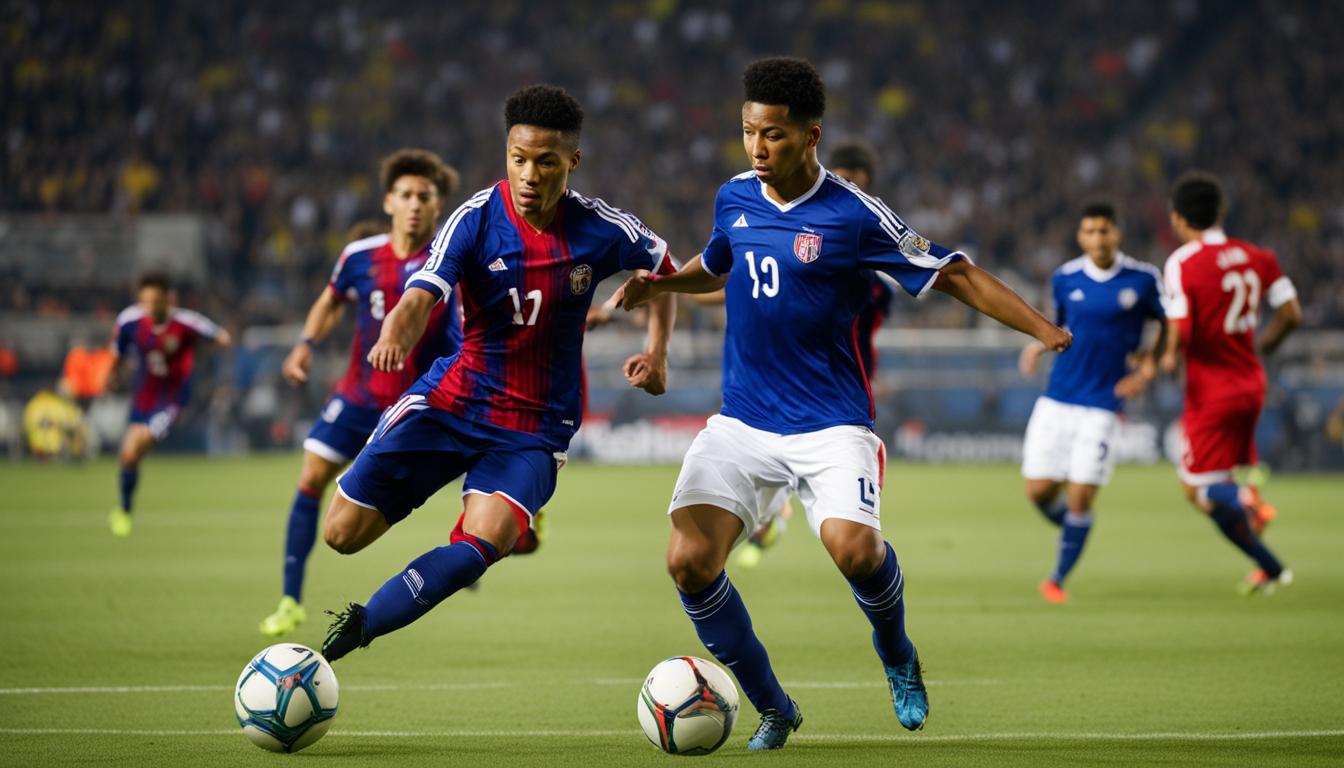Soccer is a popular sport worldwide, and understanding the different positions is crucial for success. In
Key Takeaways:
- The midfielder position is essential for controlling the game and creating scoring opportunities.
- There are various types of midfielders, including central, attacking, defensive, box-to-box, and wide midfielders.
- The central midfielder controls the game, while the attacking midfielder focuses on creating chances.
- The defensive midfielder provides support to the defense, and the box-to-box midfielder covers a lot of ground.
- The wide midfielder provides width to the team’s attack and stretches the opponent’s defense.
The Importance of the Midfielder Position in Soccer
Midfielders are the backbone of any successful
One of the key reasons midfielders are so important is their ability to dictate the tempo of the game. They control the flow of play, deciding when to slow down the game or speed it up. This control allows the team to maintain possession of the ball and create scoring opportunities. Without effective midfielders, a team can struggle to dominate the game and control the rhythm.
Midfielders also play a vital role in creating scoring opportunities for the forwards. They are responsible for making accurate passes, finding gaps in the opponent’s defense, and providing the necessary support to the attacking players. Their vision and ability to read the game are crucial in setting up goals and creating chances for their teammates. Additionally, midfielders contribute defensively, helping to break up opponent’s attacks and win back possession.
In summary, midfielders are the linchpin of a
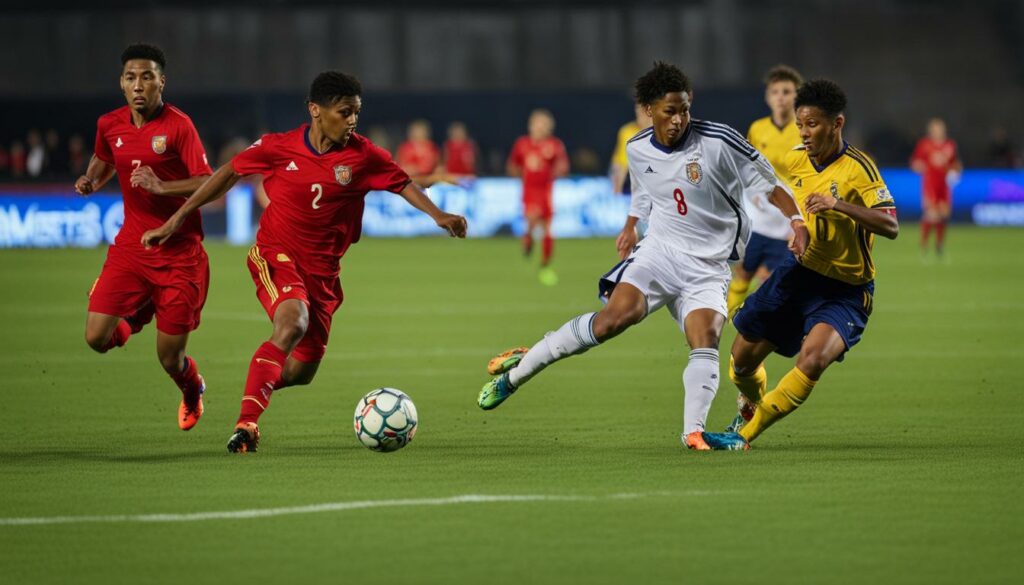
| Key Points | Benefits |
|---|---|
| Dictate the tempo of the game | Control the flow of play and maintain possession |
| Create scoring opportunities | Set up goals and provide support to forwards |
| Contribute defensively | Break up opponent’s attacks and win back possession |
The Different Types of Midfielders
In
Central Midfielder
The central midfielder is the backbone of the team’s midfield. They control the game from the center of the field, acting as the connection between the defense and the attack. Their primary responsibilities include distributing accurate passes, organizing the team’s movements, and dictating the tempo of the game.
Attacking Midfielder
The attacking midfielder is the creative force of the team. They focus on creating scoring opportunities and linking the midfield with the forwards. With excellent dribbling skills and vision, they are responsible for making accurate passes in tight spaces and setting up goals for the team.
Defensive Midfielder
The defensive midfielder is the team’s shield, providing support to the defense. They excel in tackling, positioning, and reading the game. Their primary role is to break up opponent’s attacks, win back possession, and initiate the team’s defensive play.
Box-to-Box Midfielder
The box-to-box midfielder covers a lot of ground on the field and contributes both offensively and defensively. They have a good balance between attacking and defensive abilities, supporting both ends of the field. The box-to-box midfielder makes forward runs, creates scoring opportunities, and provides defensive support by winning back possession.
Wide Midfielder
The wide midfielder provides width to the team’s attack and stretches the opponent’s defense. They are skilled in crossing, dribbling, and beating defenders in one-on-one situations. The wide midfielder operates on the flanks, delivering accurate crosses and providing defensive cover for the fullbacks.
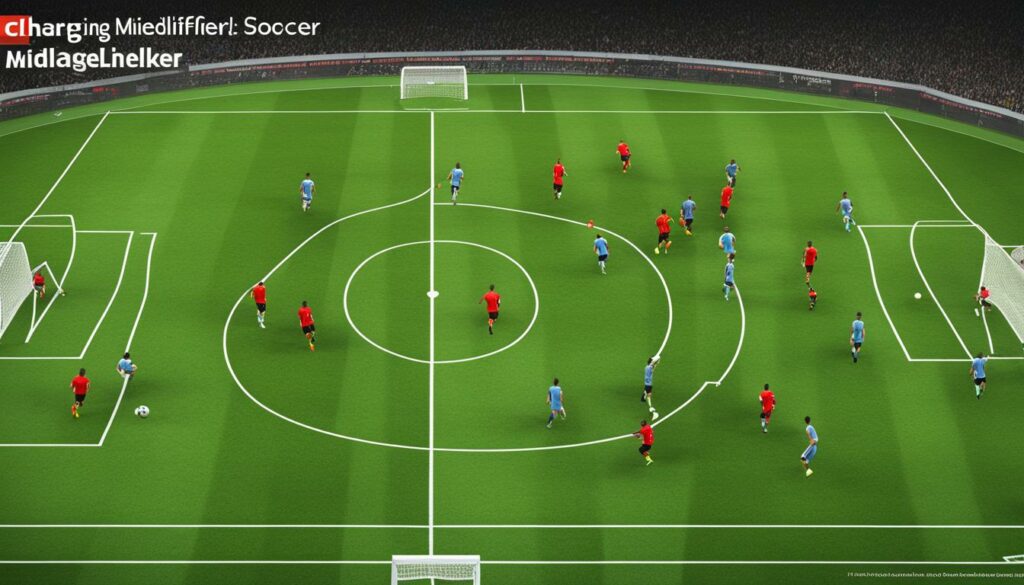
| Type | Primary Roles and Responsibilities |
|---|---|
| Central Midfielder | Control the game, distribute accurate passes, organize team’s movements, dictate tempo |
| Attacking Midfielder | Create scoring opportunities, link midfield with forwards, make accurate passes in tight spaces |
| Defensive Midfielder | Break up opponent’s attacks, win back possession, initiate team’s defensive play |
| Box-to-Box Midfielder | Cover a lot of ground, contribute offensively and defensively, make forward runs, create scoring opportunities |
| Wide Midfielder | Provide width to team’s attack, stretch opponent’s defense, deliver accurate crosses, provide defensive cover |
The Role of the Central Midfielder
The central midfielder is a key position in
One of the main responsibilities of the central midfielder is to act as a playmaker, distributing accurate passes to the forwards and creating scoring opportunities. They need to be able to switch the play quickly, finding open spaces and exploiting the opponent’s weaknesses. With their ability to control the game from the center of the field, central midfielders are often considered the heartbeat of the team.
Defensively, the central midfielder contributes by breaking up opponent’s attacks and winning back possession. They need to be tactically aware and have the ability to anticipate the opponent’s moves. Whether it’s intercepting passes, making crucial tackles, or providing cover for the defense, the central midfielder plays a vital role in the team’s defensive play.
| Central Midfielder Responsibilities |
|---|
| Controlling the game |
| Linking defense with the attack |
| Creating scoring opportunities |
| Distributing accurate passes |
| Breaking up opponent’s attacks |
| Winning back possession |
The central midfielder’s role requires a combination of technical skills, tactical awareness, and physical fitness. They need to be able to make quick decisions under pressure and have the ability to adapt to different game situations. With their ability to influence the game in both attack and defense, central midfielders are integral to the team’s success.
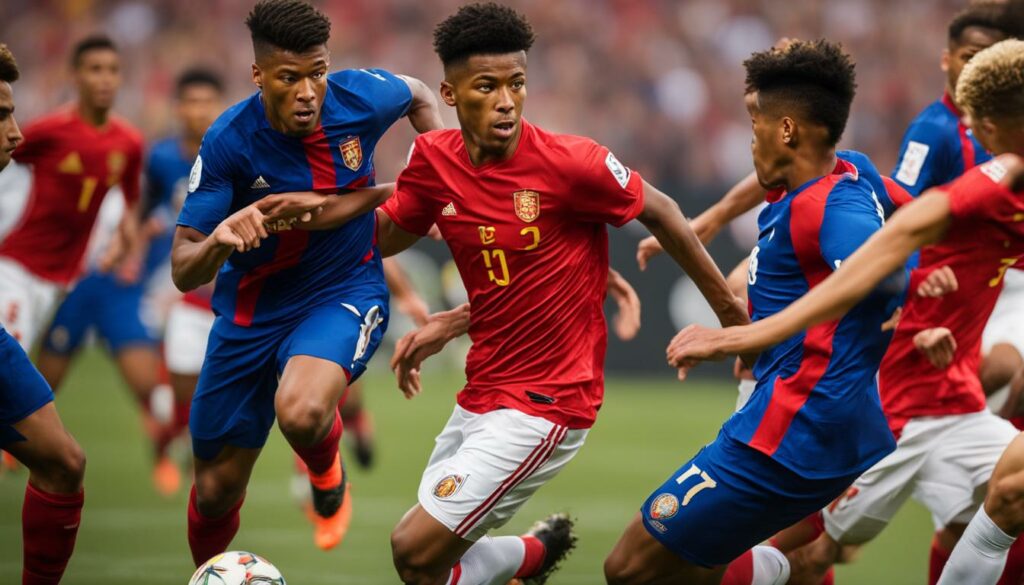
The Role of the Attacking Midfielder
The attacking midfielder is a crucial position in
One of the primary responsibilities of the attacking midfielder is to provide the final pass or assist that sets up goals. They need to have excellent vision and passing accuracy to find their teammates in scoring positions. Additionally, they possess the ability to make quick decisions in tight spaces, often using their dribbling skills to navigate through the opposition’s defense.
The attacking midfielder also has the freedom to take shots on goal themselves. With their advanced position on the field, they have a prime opportunity to score goals and contribute directly to the team’s success. Their ability to shoot from distance or create chances in the penalty area adds an unpredictable element to the team’s attacking play.
| Responsibilities of the Attacking Midfielder |
|---|
| Creating scoring opportunities for the forwards |
| Providing the final pass or assist for goals |
| Taking shots on goal and contributing to the team’s scoring |
| Using dribbling skills to navigate through the opposition’s defense |
| Having excellent vision and passing accuracy |
The attacking midfielder’s role requires a combination of technical skills, creativity, and a keen understanding of the game. Their ability to unlock defenses and create scoring opportunities for the team makes them a vital asset in any
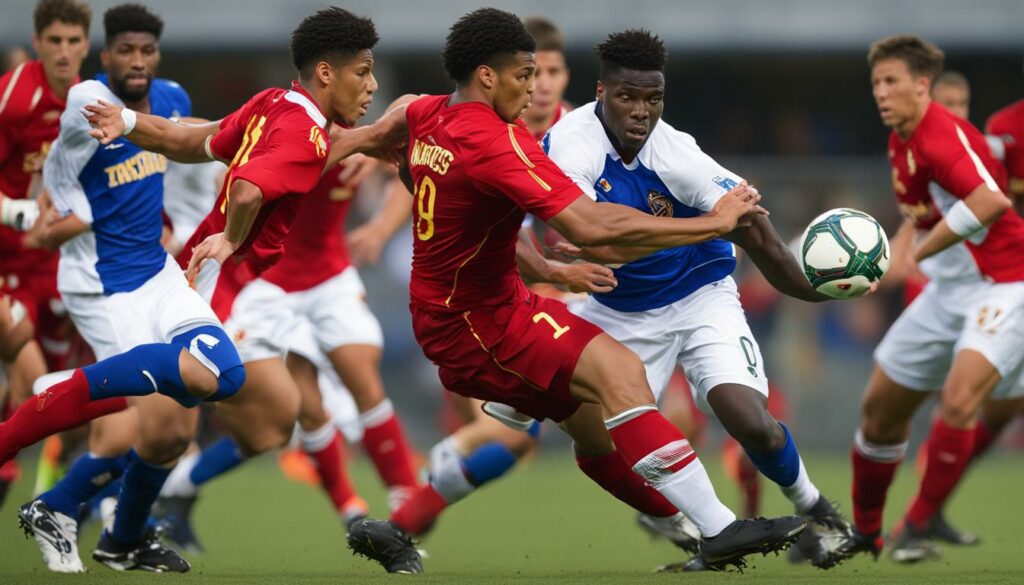
Key Responsibilities of a Defensive Midfielder:
- Provide cover and support to the defense.
- Break up opponent’s attacks and win back possession.
- Act as a shield in front of the backline.
- Initiate the team’s defensive play and start counter-attacks.
- Distribute the ball effectively and set up attacking opportunities.
- Read the game and make smart decisions.
| Skills | A | B | C | D |
|---|---|---|---|---|
| Strong tackling ability | ✔ | ✔ | ✔ | ✔ |
| Positional awareness | ✔ | ✔ | ✔ | |
| Reading the game | ✔ | ✔ | ||
| Distribution ability | ✔ | ✔ |
The Role of the Box-to-Box Midfielder
The box-to-box midfielder is a versatile player who covers a significant amount of ground on the field. They play a crucial role in both the attacking and defensive phases of the game, contributing to the overall balance of the team. This midfield position requires a unique set of skills and responsibilities.
As a box-to-box midfielder, their primary role is to provide support in both the attacking and defensive areas. Offensively, they make forward runs to create scoring opportunities and contribute to the team’s attacking play. They have the ability to join the attack and make well-timed runs into the opponent’s penalty area. Defensively, they are responsible for tracking back, winning back possession, and providing cover for the defense.
The Responsibilities of a Box-to-Box Midfielder
A box-to-box midfielder has a wide range of responsibilities on the field. Here are some key tasks they are expected to perform:
- Contributing to the team’s attacking play by making forward runs and creating scoring opportunities
- Providing defensive support by tracking back, intercepting passes, and winning back possession
- Maintaining a balance between offense and defense, understanding when to prioritize supporting the attack or helping the defense
- Covering a large area of the field, providing passing options and supporting teammates in different areas
- Having the physical endurance to maintain a high work rate throughout the game
A box-to-box midfielder needs to be a well-rounded player, possessing good passing ability, stamina, tactical awareness, and the ability to make decisive contributions in both the attacking and defensive phases. Their dynamic presence on the field significantly impacts the team’s overall performance and success.
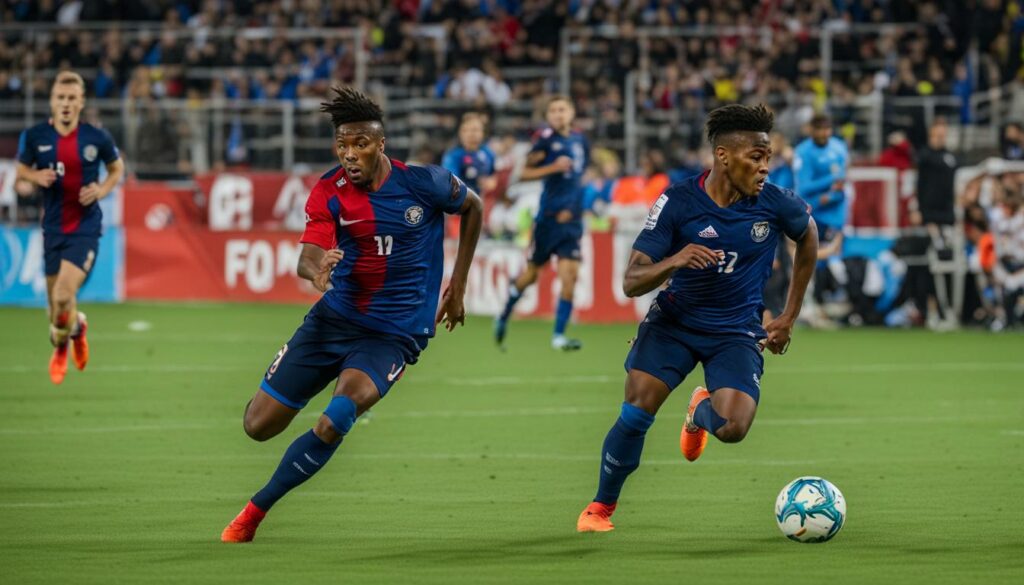
| Strengths | Weaknesses |
|---|---|
| Can contribute both offensively and defensively | May sometimes struggle to maintain consistent performance due to the physical demands of the position |
| Good stamina and work rate | Needs to be tactically disciplined to balance offensive and defensive responsibilities |
| Ability to cover a large area of the field, providing passing options and support from various positions | Maintaining positional discipline when joining the attack or tracking back defensively |
| Good passing ability to dictate the tempo of the game and link up play | Decision-making under pressure, as they may need to quickly assess whether to join the attack or help defensively |
The Role of the Wide Midfielder
The wide midfielder plays a crucial role in the team’s attack by providing width and stretching the opponent’s defense. Their responsibilities include delivering accurate crosses, beating defenders in one-on-one situations, and supporting the fullbacks defensively. With their excellent crossing ability and dribbling skills, wide midfielders are a key asset in creating scoring opportunities for the team. They are often positioned on the flanks, hugging the touchline, and making runs to receive passes from the central midfielders or fullbacks.
The wide midfielder’s primary duty is to provide width to the team’s attack, allowing the forwards to exploit spaces in the central areas. By staying wide, they force the opposition’s defense to spread out, creating gaps for their teammates to exploit. Their ability to beat defenders with dribbles and take on one-on-one situations adds an element of unpredictability to the team’s attacking play. When successfully beating their opponents, wide midfielders can deliver accurate crosses into the box, providing scoring opportunities for the forwards to capitalize on.
Defensively, the wide midfielder also plays an important role. They are responsible for tracking back and providing cover for the fullbacks, ensuring that the flanks are protected. This involves making recovery runs and helping to regain possession in defensive areas. By contributing defensively, wide midfielders provide balance to the team, helping to maintain a solid defensive shape while still being an attacking threat.
Key Responsibilities of a Wide Midfielder:
- Providing width to the team’s attack
- Stretching the opponent’s defense
- Delivering accurate crosses
- Beating defenders in one-on-one situations
- Supporting the fullbacks defensively
- Tracking back and providing cover
Overall, the wide midfielder’s role combines offensive and defensive responsibilities, making them a versatile and vital player in the team. Their ability to provide width to the team’s attack, beat defenders, and contribute defensively adds a dynamic element to the team’s playing style. A skilled wide midfielder can help create scoring opportunities, disrupt the opponent’s defense, and contribute to the team’s overall success on the pitch.
| Advantages | Disadvantages |
|---|---|
| Creates scoring opportunities with accurate crosses | May be exposed defensively if not supported by fullbacks |
| Stretches the opponent’s defense, creating gaps for teammates | Requires high fitness levels to cover a large area of the field |
| Provides width to the team’s attack | Needs strong dribbling skills to beat defenders |
| Contributes defensively by tracking back and providing cover | Requires good decision-making skills to choose when to cross or take on opponents |
Training Tips for Midfielders
Training is an essential aspect of developing as a midfielder in
1. Improve Passing Accuracy and Technique
As a midfielder, your passing ability is vital for maintaining possession and initiating attacking plays. Dedicate time to practice passing accuracy and technique. Focus on both short, quick passes and long, precise passes. Work on your ability to play one-touch passes and deliver accurate through balls to create scoring opportunities for your teammates.
2. Develop Dribbling Skills
Dribbling is another key skill for midfielders, as it allows you to navigate through tight spaces and evade opponents. Practice various dribbling techniques such as close control, changes of direction, and quick turns. Work on your ability to maintain possession while under pressure and create opportunities to advance the ball up the field.
3. Enhance Positional Awareness
One of the essential aspects of playing as a midfielder is having a high level of positional awareness. Train your ability to read the game and anticipate movements from both your teammates and the opposition. Understanding where to position yourself on the field will allow you to make effective passes, intercept passes from the opposing team, and contribute defensively.
4. Improve Fitness and Endurance
Midfielders cover a significant amount of ground during a match, requiring good fitness and endurance levels. Incorporate cardiovascular exercises, such as running and interval training, into your training routine. Additionally, focus on building strength and agility through weightlifting and plyometric exercises. A high level of fitness will enable you to maintain a high work rate throughout the game.
5. Study Game Tactics and Strategies
Become a student of the game by studying various tactics and strategies employed by successful teams and midfielders. Analyze professional matches, pay attention to the movements and decision-making of midfielders, and seek to understand how they contribute to the team’s success. This knowledge will help you make smarter decisions on the field and adapt to different game situations.
6. Practice Shooting and Scoring Goals
While midfielders are primarily responsible for facilitating play and supporting both the defense and attack, they can also contribute goals to the team. Dedicate time to work on your shooting technique and practice scoring goals from different positions on the field. Developing your scoring ability will make you a more well-rounded midfielder and provide an additional threat to the opposing team.
By incorporating these training tips into your routine, you can enhance your skills as a midfielder and make a significant impact on the team’s success. Remember to maintain consistency in your training, stay dedicated, and always strive for improvement. With time and effort, you can become a standout midfielder in
Choosing Your Midfielder Position
When it comes to playing in the midfield, there are several different positions to consider. Each position has its own unique role and responsibilities, so it’s important to choose the one that best suits your skills and playing style. In this section, we’ll explore the three main midfielder positions: central midfielder, attacking midfielder, and defensive midfielder, and provide some guidance on how to choose the right position for you.
Central Midfielder
The central midfielder is often considered the “maestro” of the team, responsible for controlling the flow of the game and distributing the ball. If you have excellent passing ability, vision, and a good understanding of the game, the central midfielder position may be the right choice for you. This position requires strong leadership skills and the ability to dictate the tempo of the game. As a central midfielder, you’ll be involved in both attacking and defensive aspects of the game, contributing to your team’s success in various ways.
Attacking Midfielder
If you have a creative mind and love to be involved in the team’s attacking play, the attacking midfielder position may be a perfect fit for you. Attacking midfielders are responsible for creating scoring opportunities, linking the midfield with the forwards, and providing that final pass to unlock the defense. You’ll need excellent dribbling skills, vision, and the ability to make accurate passes in tight spaces. As an attacking midfielder, you’ll be at the heart of every attacking move, playing a crucial role in your team’s success in front of the goal.
Defensive Midfielder
For those who excel in defensive abilities and enjoy breaking up opponent’s attacks, the defensive midfielder position is worth considering. Defensive midfielders provide support to the defense, acting as a shield in front of the backline. This position requires strong tackling ability, positional awareness, and the ability to read the game. As a defensive midfielder, you’ll play a crucial role in winning back possession, starting counter-attacks, and providing defensive stability for your team.
When choosing your midfielder position, it’s important to assess your strengths and preferences. Consider your skills, playing style, and the role that you enjoy the most. Don’t be afraid to experiment with different positions during training and matches to find the one that suits you best. Remember, each midfielder position is important and contributes to the overall success of the team. Choose the position that allows you to showcase your skills and make a significant impact on the game.
Conclusion
The midfielder
Throughout this comprehensive guide to midfielders, we have explored the different types of midfielders and their specific roles on the team. From the central midfielder who controls the game from the center of the field, to the attacking midfielder who is the creative force, and the defensive midfielder who protects the defense – each role contributes to the team’s success.
By understanding the responsibilities of each midfielder position and following the training tips provided, aspiring players can develop their skills and become effective midfielders. Remember to choose the position that best fits your abilities and playing style, and continue to work on improving your skills through dedicated training and practice. With determination and hard work, you have the potential to master the midfielder
